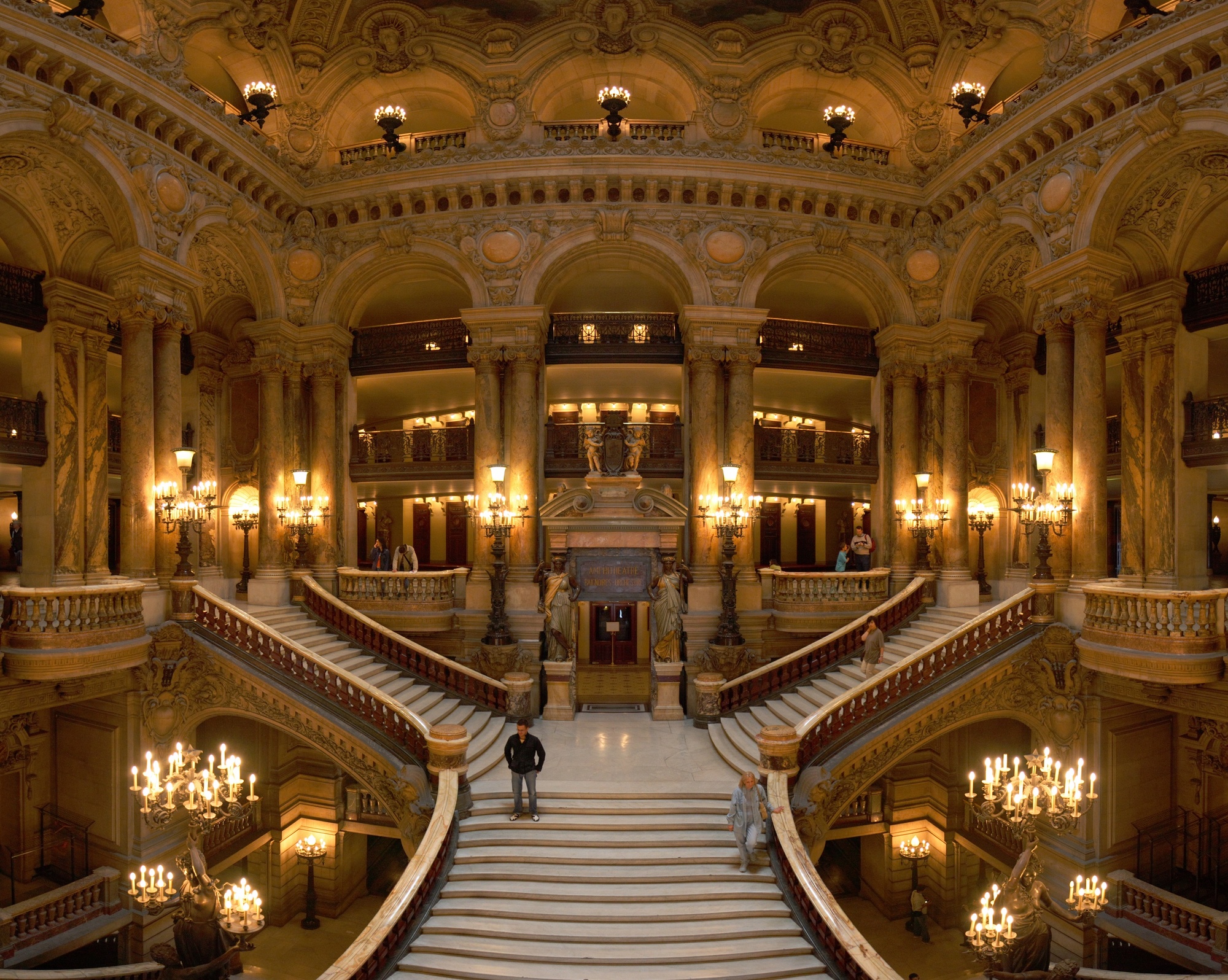Le Palais Garnier, Paris
Le Palais GarnierThe Palais Garnier, home of the Paris Opera, was built between 1860 and 1875 and even to rough rural kiwis like me it's spectacular. But I think what appeals to me is not merely the sheer opulence, but that it's more than an historical monument — it's a place that still lives vibrantly through the performances that take place there and everything those performances entail.
Music Hall Monday: Paris Opera House
This week on Music Hall Monday, we visit The Paris Opera House (now known as the Palais Garnier). which was built by architect Charles Garnier between 1857 - 1874. The building, located in the 9th arrondissement in the heart of Paris, is known for it's ornate exteriors of the Neo-Baroque style.For a lover of symmetry, this street layout is just spectacular! The current urban planning of Paris was brought about by the controversial Baron Haussman in the 19th Century.
Palais Garnier
Opera Garnier Grand Escalier
Palais Garnier is one of the buildings in Paris, France, which serves to show the art of opera. The building was designed by Baron Haussmann in 1858, and was built by Charles Garnier in 1861. Palais Garnier stage is estimated to accommodate 450 actors and actresses and can accommodate 2000 people auditorumnya
Palais Garnier is a theater of the 13th Paris Opera that was formed by Louis XIV since 1669. Palais Garnier was built on the orders of Napoleon III as part of reconstruction projects 'great Parisian'. Charles Garnier as the architect of this building for 15 years,
. For those of you who are happy with opera performances must visit this place
Paris Journal: In the Depths of the Palais Garnier
PARIS — Less than an hour ago, I was deep down in the bowels of the resplendent Palais Garnier, peering through the caged entry to a descending stone staircase that leads to utter blackness, listening to the lapping waters of the palatial old opera house’s legendary underground lake, and hoping to catch the stirrings, maybe even a glimpse, of the phantom of the opera.Yes, this magnificent house, which opened in 1875, was the setting of Gaston Leroux’s 1910 gothic novel, which in turn inspired several plays, films and, most famously, Andrew Lloyd Webber’s melodramatic money-machine of a musical. The legend of the opera house phantom, a horribly disfigured musical genius who stalked the halls of the place and demanded that Box Five always be reserved for him, may be just that, a legend. But the subterranean lake below the building where he is supposed to have lived is quite real.
I learned this first-hand today when Joachim Pflieger, the charming and efficient young assistant to Gerard Mortier, the director of the Paris National Opera, took me on a tour of the Garnier. Mr. Pflieger seems to know everything about the building and its history.
After construction of the house began in the early 1860s, a subterranean stream was discovered. It took eight months of pumping to drain the water, or most of it. Charles Garnier, the visionary architect who designed the building and supervised its construction, came up with a way to turn the problem of the subterranean stream into an asset. He collected the water into a pool, Mr. Pflieger told me, reasoning this would serve like ballast in the bottom middle section of a ship, providing stability to the structure, in this case, a gargantuan opera house with massive marble lobbies and such. Or something like that. I’m not sure I followed his explanation.
If there were no sightings of the phantom, it was sure fun to see its aquatic underbelly. And the Palais Garnier is the opera-house equivalent of Versailles.
The 2,200-seat theater looks a little dusty these days. But with its ornate, Neo-Baroque decorative touches and circular rings of balconies, it is still a breathtaking place to experience opera. Behind the stage, off by itself, is an elegant private reception room with marble columns and murals, the Foyer de la Danse, where wealthy patrons of the ballet would come after performances to mingle with young dancers. You can imagine what kind of personal arrangements were made between the beautiful artists and their older admirers.
But, for all its splendor, the Palais Garnier is a place for working. Mr. Pflieger took me to an upstairs rehearsal room for dance, and when we spied through the window in the door, there, to his surprise and my delight, was Mikhail Baryshnikov rehearsing a duo with the veteran dancer Ana Laguna.
Mr. Pflieger actually studied political science and philosophy in college. But it makes sense that Mr. Mortier would have an assistant who did not major in music or the arts. “To Gerard Mortier, opera is all politics,” Mr. Pflieger explained.







No comments:
Post a Comment